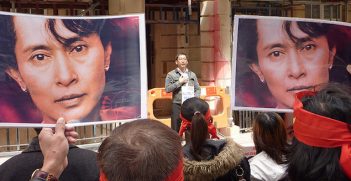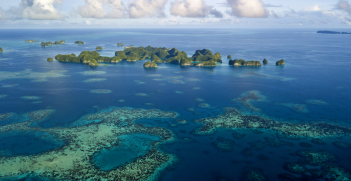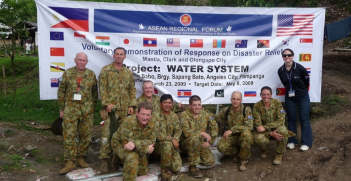Hard Won Progress at the Nuclear Security Summits
The recent Nuclear Security Summit held in the Netherlands achieved notable progress towards global nuclear security, but the long-term goal of a nuclear security regime will require hard work.
On 5 April 2009, U.S. President Barack Obama announced a new international initiative to secure all vulnerable nuclear material around the world, aimed at preventing nuclear terrorism. Exactly five years and three Summits later, his ambitious goal is still far from being achieved: an estimated 1390 tons of highly enriched uranium (HEU) and 490 tons of separated plutonium still exists in military and civilian nuclear programs around the world, much of it at risk of theft or sabotage. This has led some to question whether the Summit process has been worth all the time and money invested in it – a fair question given all the other pressing priorities demanding international cooperation.
The answer is that despite the delays and disappointments, the Nuclear Security Summits have played a critical role in raising awareness of nuclear dangers and have put pressure on political leaders to address them. They’ve led to concrete progress that’s easy to quantify. Since the first Summit in 2010, 12 countries have completely eliminated their HEU stockpiles, 15 have reduced theirs, and the number of countries that possess enough nuclear material to build a nuclear weapon has fallen from 39 to 25. This is a huge achievement, involving four years of painstaking cooperation between the original suppliers and the recipients of the HEU. Most importantly, it demonstrates a growing acceptance among many political leaders that reducing nuclear vulnerabilities is an international responsibility as well as a national obligation.
Last week’s Nuclear Security Summit in the Netherlands saw progress in two important new areas. First, some states pledged to reduce their stocks of plutonium, not just their HEU, setting an important precedent for the next Summit. Japan announced that it will return 330 kg of plutonium and 170 kg of uranium from its Tokai facility to their countries of origin (the US and UK). Japan uses its nuclear materials for peaceful purposes, but this is the equivalent of 50-70 nuclear bombs worth of material, even a fraction of which could be lethal in the wrong hands. Agreeing to ship it out of Japan is a very positive step, especially given that experts have identified serious security lapses at Japan’s storage sites and highlighted the Japanese nuclear industry’s reluctance to deal with potential insider threats. Unfortunately, there’s plenty more plutonium in Japan, but at least the Tokai pledge has started the ball rolling, with Italy and Belgium also promising to reduce their plutonium stocks. Others might follow their lead at the next Summit, which is due to be held in Obama’s hometown of Chicago in 2016.
The other area of progress was in first steps towards regime-building. The Summits have always been regarded by the US and others as a temporary process; part of a larger goal of building an over-arching nuclear security architecture that is sustainable over the long-term. But until the Netherlands meeting, very little progress had been made in achieving this goal, with most states at the Summits narrowly focusing on national commitments. Many commentators have been worried about this, concerned that momentum at the heads of state level will end without creating a more permanent framework to benchmark, review and improve global nuclear security standards. This time around, the hosts of the 2010, 2012 and 2014 Summits (the US, South Korea, and the Netherlands) decided to come together to address this problem and achieved some success: 35 states signed up to their Strengthening Nuclear Security Implementation (SNSI) initiative, committing them to implement the nuclear security standards recommended by the International Atomic Energy Agency (IAEA).
Admittedly, it’s still a long way from a formal nuclear security regime, which is far from ideal, especially if the next Nuclear Security Summit really is the last one, as expected. The problem is that there’s still strong resistance to regime-building among some states that reject any mandatory nuclear security commitments that might encroach on their national sovereignty. This resistance has been loud and clear at all three Summits, as well as in regional meetings in the Asia-Pacific and UN forums in Geneva, New York and Vienna, so it wasn’t surprising to learn that the SNSI initiative failed to attract the support of 18 states, including China, India and Pakistan. Winning the support of these countries for the creation of a formal, over-arching regime is critical, but the reality is that it will be a laborious process; each step forward is likely to be hard won.
What should the next steps be, in preparation for 2016 and beyond? In addition to using the Summit’s Sherpa and sous-Sherpa meetings to encourage states to fulfil their Summit promises and to build further support for the IAEA’s nuclear security role, more emphasis needs to be placed on developing lower-level initiatives that operate at the regional and sub-regional levels. These should focus on education and on information-sharing – especially exchanging ideas on best practice among officials, nuclear industry operators and regulators. This would help ensure that attention doesn’t dissipate once the Summit process ends, and would help build some of the trust and confidence needed for the longer-term development of a formal nuclear security regime.
Dr Tanya Ogilvie-White is Research Director and Associate Professor at the Centre for Nuclear Non-Proliferation and Disarmament, Australian National University and Fissile Material Working Group (FMWG) Regional Representative for the Asia-Pacific.





